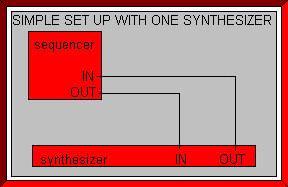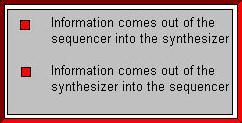by H. M. Sowards
This page is for beginning to intermediate MIDI users who would like to understand a bit more about how MIDI sequencing works. A page of tips for advanced MIDI users is in the works for the future... but I wouldn't start holding your breath... I'm really busy at the moment!
WHAT IS A MIDI SEQUENCER?
A MIDI sequencer is similar to a multi-track audio tape recorder in that it
stores
a musical performance. It even has similar controls: PLAY, RECORD,
STOP &
PAUSE. However, a MIDI recorder does not record sound. It records data
about
each note that is played. This information includes notelength, pitch,
pitch bend, and
velocity. MIDI data can then be edited and manipulated in
many ways (i.e. copy, paste, cut, quantize, etc.) that are impossible on a
conventional tape recorder. Since only information about each note is being
recorded and not the actual sound itself, you can
play back MIDI recorded
tracks at slower or faster temps and not get a change in pitch. Possible
advantages of this is being able to record a difficult part at a slower tempo
and then speed it up to the desired tempo upon playback. Sequencers come in
a variety
of forms: Onboard (internal) Sequencer which built directly into
a synthesizer or sampler, Off-board (external-dedicated) Sequencer which is a
stand alone unit used only for sequencing, and the Software (virtual) Sequencer
which is a program that runs on your home computer (this is the most popular
type of sequencer at the moment).
BRIEF HISTORY OF MIDI SEQUENCERS
Berfore the induction of MIDI (Musical Instrument Digital Interface) in
1982, there
were analog sequencers. They would spit out pre-programmed
voltages to a sound
generator to produce a series of notes. The patterns
they played were liimited and
there were not any editing or manipulation
capabilities. The early digital sequencers
before MIDI were a blend of the "then
new" digital technologies and old analog (voltage) technology. They had a
digital memory and control voltage inputs. They were more
acurate and in
tune than the analog sequencers, but still very limited with no editing or
synching capabilities.
Before MIDI there were many compatibility problems... Brand X's
sequencer might not work with Brand Y's synthesizer... This limited musicians to
sticking to one brand for
their electronic music gear. Then the MIDI
protocol came along. The MIDI protocol
got all different electronic misc
devices manufactured by different companies speaking the same language. This
allows musicians to mix and match the brands of equipment they use to fit their
needs. It also allows for third parties to create all sorts of utilities and
software for MIDI.
MIDI SEQUENCER GUIDELINES
| Types of data that MIDI sequencers record | |
| NOTE LENGTH | how long each key is held down |
| KEY VELOCITY | the speed that the key is pressed. The range of attack velocities are (1 - 127) |
| PITCH | What pitch is the note... based on the MIDI note
numbers (21 - 108) Which corresponds to the 88 keys of a grand piano. |
| MIDI CHANNEL | the channel that each device is transmitting or recognizes |
| AFTER TOUCH | how hard the keys are pressed |
| CONTROLLER DATA | data such as sustain, modulation, pan, pitch bend etc. |
| PROGRAM / PATCH CHANGES | sound change information. |
![]() Most sequencers these days
have multiple tracks... though some only have a couple. Multiple tracking is
possible on those devices by merging tracks
Most sequencers these days
have multiple tracks... though some only have a couple. Multiple tracking is
possible on those devices by merging tracks
![]() MIDI data is associated
with a specific MIDI channel. (i.e. Drum part may be recorded on channel 16,
Strings may be on channel 15, Piano on channel 14... and so on)
MIDI data is associated
with a specific MIDI channel. (i.e. Drum part may be recorded on channel 16,
Strings may be on channel 15, Piano on channel 14... and so on)
![]() Resolution: how many parts
the sequencer divides a quarter note into. The higher the resolution, the more
acurate the sequencer playback will be. A resolution of 96
parts per quarter note is a good minimum standard.
Resolution: how many parts
the sequencer divides a quarter note into. The higher the resolution, the more
acurate the sequencer playback will be. A resolution of 96
parts per quarter note is a good minimum standard.
MIDI SEQUENCER FEATURES
![]() Quantization: used
to correct minute rythmic errors... or add swing or shuffle
Quantization: used
to correct minute rythmic errors... or add swing or shuffle
to a specific
phrase. Quantizing a track to a chosen note value (quarter, eighth, triplet,
etc.) will line notes in the track to the neares multiple of that note value.
![]() Step-time input: Allows
you to enter notes one at a time while the computer
Step-time input: Allows
you to enter notes one at a time while the computer
waits for you to enter
in the next one. This is very useful for difficult passages that are impossible
to play live. On software sequencers you will see a variation of this type of
step-time input called a "grid" or "matrix" editor. This
allows you to "draw" in the notes
and note lengths you want.
![]() Punch-in recording:
This allows you to re-record a specified amount of
Punch-in recording:
This allows you to re-record a specified amount of
measures anywhere in
the middle of a song.
![]() Looping: Used to
repeat a specified section. You can choose the beginning
Looping: Used to
repeat a specified section. You can choose the beginning
and end points of
the loop and the number of times you want it iterated.
![]() MIDI event filtering:
You can specify to your sequencer to filter out certain
MIDI event filtering:
You can specify to your sequencer to filter out certain
MIDI event information... such as pitch bend, velocity, modulation,
sysex...etc. This
allows you to save memory if the parts you are recording
do not require those pieces
of data.
![]() Transposition:
Self explanatory. You can choose what key
Transposition:
Self explanatory. You can choose what key
track(s)/measures/notes are
transposed to.
![]() Patch Changing: Allows
you to tell the sequencer to change patches (sounds)
Patch Changing: Allows
you to tell the sequencer to change patches (sounds)
on a particular
synthesizer or channel during playback.
![]() Song Position Pointer:
Allows you to start playback of a song in the middle.
Song Position Pointer:
Allows you to start playback of a song in the middle.
The sequencer will
send out a message telling all external devices where it is starting the song
and the machines will then follow.
MULTI-TIMBRAL INSTRUMENTS
![]() A Multi-timbral
synthesizer is an instrument that will play more htan one sound at once on
different MIDI channels. This is a good alternative to using many different
synthesizers that will only play one voice and one channel at a time.A good
example of a Multi-timbral synth would be the K2000 which allows you to play up
to 16 instruments
A Multi-timbral
synthesizer is an instrument that will play more htan one sound at once on
different MIDI channels. This is a good alternative to using many different
synthesizers that will only play one voice and one channel at a time.A good
example of a Multi-timbral synth would be the K2000 which allows you to play up
to 16 instruments
at a time and gives you 64 note polyphony.
SOFTWARE SEQUENCERS
![]() Software sequencers are
programs you can run on your home computer.
Software sequencers are
programs you can run on your home computer.
![]() The advantages of a
software sequencer include: More memory, more intensive editing features,
Graphical display.
The advantages of a
software sequencer include: More memory, more intensive editing features,
Graphical display.
![]() Besides the software for
your computer, you will need a MIDI interface for your
Besides the software for
your computer, you will need a MIDI interface for your
computer. For the PC most sound cards have MIDI capabilities and just need
the
correct cable to plug into the joystick port on the back of your
soundcard. However, if your PC doesn't have a sound card then you will need to
get a MIDI card. The most common is the Roland MPU-401 or a MPU-401
compatible card. This card is a circuit board that you install in
your computer that has a MIDI IN and OUT port that sit outside the chassy of the
computer. For the MAC, the MIDI interface usually plugs straight
into
the printer port.
SET UP
![]() MIDI "OUT"
ports (information going out) connect to MIDI "IN" ports
MIDI "OUT"
ports (information going out) connect to MIDI "IN" ports
![]() MIDI "THRU"
ports (MIDI echo informtaion) are connected to MIDI "IN"
MIDI "THRU"
ports (MIDI echo informtaion) are connected to MIDI "IN"
ports
![]() The ports are connected
with MIDI cables, which only transmits the data in one direction
The ports are connected
with MIDI cables, which only transmits the data in one direction

